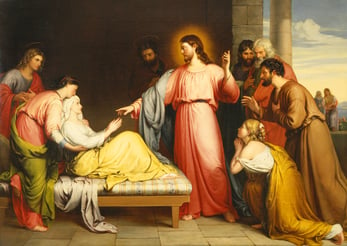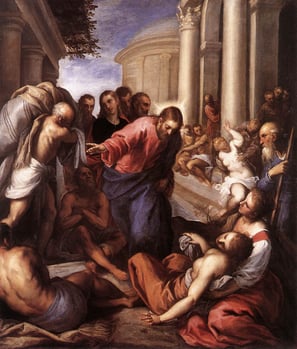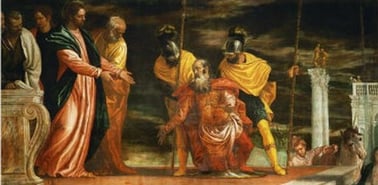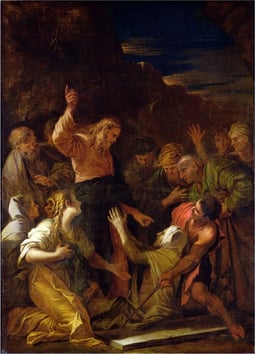Accounts of Jesus’ miracles are presented differently than miracles in Hellenistic or Old Testament writings. Jesus’ miracles are not only portrayed as direct manifestations of His divine power but, perhaps even more strikingly, as the initiation of the Kingdom of God and the vanquishing of Satan.
Catholic priest and biblical scholar Raymond Brown (1928-1998) recognized five unique, consistent features in the presentation of Jesus’s miracles in all four Gospels:
- Jesus does miracles by His own authority.
- Jesus’ miracles actualize the coming of the Kingdom and the vanquishing of evil.
- Jesus is not a wonder worker or magician in either the pagan or Jewish sense.
- Jesus combines teaching and miracles.
- The faith/freedom of the recipient is integral to the miraculous deed.
Jesus’s Miracles Are by His Own Authority
 Christ Healing the Mother of Simon Peter’s Wife by John Bridges, Public domain / via Wikimedia Commons
Christ Healing the Mother of Simon Peter’s Wife by John Bridges, Public domain / via Wikimedia Commons
Jesus exorcises, heals, and raises the dead by his own power and by His own word.
The Old Testament prophets did not do anything like this but believed themselves to be only mediators of God’s power, and so they had to petition God to help them and work through them.
Indeed, the greatest prophetic miracle workers of the Old Testament—Elijah and Elisha—would not have dared to make the claim that the power of God resided in them.
Jesus’s Miracles Actualize the Coming of the Kingdom and the Vanquishing of Evil
 Walking on Water by Ivan Ayvazovsky, Public domain / via Wikimedia Commons
Walking on Water by Ivan Ayvazovsky, Public domain / via Wikimedia Commons
Jesus’ miracles actualized the kingdom of God. They did so by vanquishing the power of Satan in the world.
This interpretation is not only integral to virtually every miracle story in the Gospels but also explicitly mentioned in the primitive Church’s kerygmas.
As Brown notes, “Jesus is accomplishing something no one has ever done before since Adam’s sin yielded to Satan’s dominion over this world.”
Inasmuch as Jesus is accomplishing something totally unique, the Gospel writers are totally unique in writing about it.
Jesus Is Not a Wonder Worker or Magician in Either the Pagan or Jewish Sense
 Jesus Healing a Deaf-mute by Bartholomeus Breenbergh, Public domain / via Wikimedia Commons
Jesus Healing a Deaf-mute by Bartholomeus Breenbergh, Public domain / via Wikimedia Commons
Though it is popularly believed that there were many miracle workers during Jesus's time, there is little evidence for this.
Furthermore, among the accounts of miracle workers, none resemble Jesus in either style or purpose.
The Gospel writers not only avoid the portrayal of Jesus as a worker of “astonishing deeds,” but Jesus Himself is also portrayed as shunning such a purpose. Indeed, when Herod, the Pharisees, and the devil asked Jesus to work a miracle for no other purpose than to show off His power, He refused to do so. The uniqueness of Jesus Christ in this matter is striking.
Moreover, the term magic is never used to describe Jesus’ activity by His disciples, the Jewish authorities, the early Church, Jesus’ fiercest critics, or Jesus Himself.
Furthermore, if Jesus were to have been accused of magic, it would have carried a very pejorative connotation within the Jewish culture of His time and even after His death. However, the New Testament accounts militate against this interpretation by continuously noting that Jesus’ miracles are greeted with amazement and praise by His Jewish audience (while magic would have been viewed quite negatively).
Jesus Combines Teaching and Miracles
 The Pool by Palma il Giovane, Public domain / via Wikimedia Commons
The Pool by Palma il Giovane, Public domain / via Wikimedia Commons
Unlike both the pagan and Jewish miracle workers of the time, Jesus integrated teaching into his miraculous deeds.
His miracle accounts in the gospels included lessons about faith, the forgiveness of sins, seeing through the eyes of faith, giving thanks, the kingdom of God, salvation for the Gentiles, and even the Holy Eucharist.
If one looks at it from another direction, Jesus is a rabbinical teacher who amplifies His teaching with deeds of power and wonder.
The Faith/Freedom of the Recipient of Jesus’s Miracles Is Integral to the Miraculous Deed
 Jesus Healing the Servant of a Centurion by Paolo Veronese, Public domain / via Wikimedia Commons
Jesus Healing the Servant of a Centurion by Paolo Veronese, Public domain / via Wikimedia Commons
Unlike pagan and Jewish miracle-workers of the time, Jesus used miracles to call forth faith.
The oft-repeated lines, “Go now, your faith has saved you,” or “Do you believe that I can do this?” move the recipient of the miracle beyond physical healing to faith and ultimately toward salvation.
Notice that this call to faith involves the highest use of the recipient’s freedom.
Jesus wants the recipients in their freedom to enter into a life of salvation through the vehicle of His deed of power. The miracle workers of Jesus’ time do not have this intention.
The Uniqueness of Jesus's Miracles
 Christ Cleansing a Leper by Jean-Marie Melchior Doze, Public domain / via Wikimedia Commons
Christ Cleansing a Leper by Jean-Marie Melchior Doze, Public domain / via Wikimedia Commons
These five unique aspects of Jesus’ miracles reveal that the Gospel writers are not “competing” with other miracle workers, or even trying to “show off” the astonishing power of Jesus.
Rather, they were trying to convey Jesus’ intentions to initiate the Kingdom of God and vanquish Satan in the world in a remarkably restrained and humble way. In other words, they provide compelling evidence for the uniqueness of Jesus Christ.
*Cover Image: Andreas F. Borchert, CC BY-SA 3.0 DE / via Wikimedia Commons Cropped to the size 1700x850.
**Originally Published on August 31, 2020.

